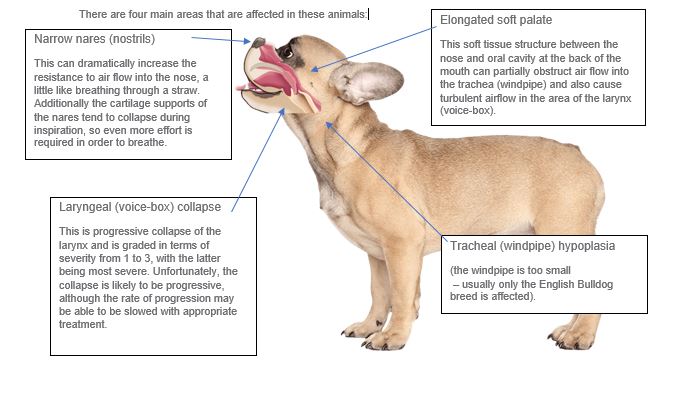Brachycephalic obstructive airway syndrome is the term given to the effects of a significantly shortened nose.
These signs mainly affect the passage of air through the upper airways with severity of signs varying from mild snoring or snorting noises to severe breathing problems. Animals suffering from BOAS can often struggle to breathe during periods of exercise and can even suffer collapse. Dogs can only mainly cool themselves down by panting and sweating through their paws – excessive panting can be problematic for BOAS patients making them very high risk for overheating.
What breeds are affected?
Brachycephalic breeds of dog are those that have a marked short or squashed nose appearance, and any breed of dog with such a conformation can be affected e.g.
- English or French Bulldog
- Pug
- Boxer
- Lhasa Apso
- ShihTzu
- Pekingese
- Dogue de Bordeaux
- Cavalier King Charles Spaniel
- And many more
Why do these animals have problems?

Unfortunately, due to the extra effort required for inspiration (breathing in), secondary problems develop. These secondary effects include:
- Tonsillar eversion and hypertrophy. The tonsils sit in the back of the mouth - increased negative pressures can cause them to enlarge and they can bulge into the back of the mouth, further obstructing the airway.
- Pharyngeal muscle hypertrophy. The pharynx is the chamber at the back of the mouth before the entrance to the oesophagus (food pipe) and larynx (voice-box). The muscles in this chamber can become hypertrophied (enlarged) due to negative pressure in the upper airway.
- Acid reflux from the stomach into the oesophagus (food pipe). This can then damage the oesophagus lining and stomach wall, causing ulceration. Some severe cases can suffer from a hiatal hernia where part of the stomach can become displaced into the chest cavity during breathing.
- Heart failure – this is less common than the other secondary effects of BOAS.
How is BOAS diagnosed?
Our vets will carry out a physical examination and assess your pet’s anatomy – some dogs of the same breed can be affected more than others. They will also gain a history and assess how well your dog copes and the degree of clinical signs attributed to BOAS – particularly in warm conditions and during exercise. The majority of brachycephalic will at the very least experience snorting or snoring as a degree of upper airway obstruction.
The nares (nostrils) can be assessed as part of the physical examination, but further evaluation would need to be carried out under general anaesthetic. Our advice on whether to proceed with further diagnostics will be evaluated based on the above – essentially if your pet is experiencing a significant level of signs or
showing an anatomical conformation that may predispose him/her to problems.
How is BOAS investigated by the veterinary surgeon?
Further investigations are dependent on the initial consultation and physical examination but often include imaging of the chest, evaluation of the oral cavity under general anaesthetic and sometimes blood tests. General anaesthetic risks are higher in brachycephalic dogs, so we have a specific anaesthetic
protocol for these cases to ensure as much safety as possible.
What treatment options are available?
| Surgical treatment is available for: Stenotic nares Widening the nares by surgically removing a section of cartilage can improve the airflow. Elongated Soft Palate Surgically shortening the length of the soft palate to improve air flow into the larynx. Laryngeal Collapse This is dependent on the severity, mild cases can have some tissue that is slowing the airflow, in severe cases a more complex procedure is required. Everted tonsils Surgical removal of the tonsils may improve the condition in some cases. |
Medical treatment is available for: Acid reflux and/or hiatal hernia Treatment for gastric reflux usually involves regular medication, rather like one might take for heartburn. We often use conservative management for cases with a hiatal hernia, but some severe cases require surgery. |
Weight management
It is difficult to lose weight from a severe BOAS patient who is also obese as often there is a reduced ability to exercise safely. Therefore the lifestyle of these patients from an early onset is an extremely important factor. Maintenance at an optimum weight to ensure minimal extra tissue (due to fat) around the face and neck is essential.
Treatment plans are selected on a case-by-case basis, and one of our vets will be able to discuss options during a consultation and/or following diagnostics.




